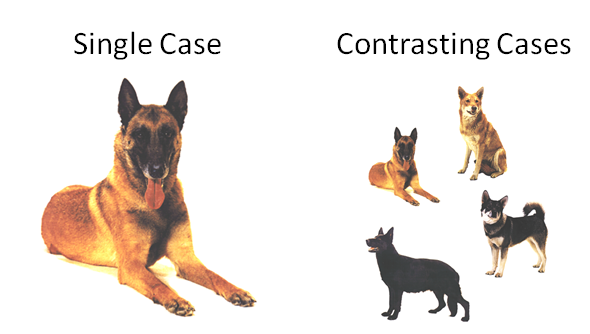Inventive Learning
These projects have the goal of supporting the development of early knowledge.
Contrasting Cases

Contrasting cases are collections of problems or examples that help students understand the quantitative structure of empirical phenomena. They are designed to present optimal variation for learning functional structures that capture how distinct quantifiable elements combine to make new properties (e.g. density is a ratio of mass over volume).
Based on prior research, contrasting cases can foster an appreciation of deep structure, flexibility, transfer, and preparation for future learning. We (and others) have had demonstrated success using contrasting cases to help students learn functional structures across a variety of STEM domains ranging from statistical variance to electromagnetic fields. For example, in Schwartz et al., 2011, we reported that inducing the functional structure of ratio over a series of contrasting cases about speed and density caused transfer to a semantically unrelated problem (spring constant) several weeks later.
Relevant publications:
- Chin, D.B., Chi, M., and Schwartz, D.L. (2016) A comparison of two methods of active learning in physics: Inventing a general solution versus compare and contrast. Instructional Science, 44(2): 177–195.
- Shemwell, J., Chase, C.C., and Schwartz, D.L. (2015). Seeking the general explanation: A test of inductive activities for learning and transfer. Journal of Research in Science Teaching, 52(1): 58–83.
- Schwartz, D. L., Chase, C. C., Oppezzo, M. A., & Chin, D. B. (2011). Practicing versus inventing with contrasting cases: The effects of telling first on learning and transfer. Journal of Educational Psychology, 103(4), 759-775.
- Inventing with Contrasting Cases & Tell and Practice Worksheets
- Schwartz, D. L., & Martin, T. (2004). Inventing to prepare for learning: The hidden efficiency of original student production in statistics instruction. Cognition and Instruction, 22, 129-184.
Acknowledgement:
This work was supported in part by the Institute of Education Sciences, U.S. Department of Education, award number R305A140314. The opinions expressed are those of the authors and do not represent the views of the Institute or the U.S. Department of Education.
